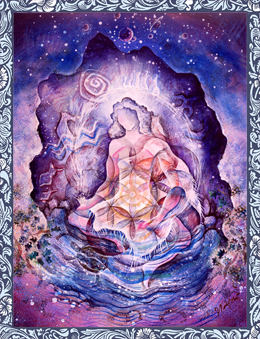 I have noticed that in many spiritual traditions the ego is considered a negative thing, and in many psychological traditions it is considered a positive thing. What is the truth in this matter? As we explore this issue, let’s take a peek into the many ways the ego shows up in the energy field. The first place I notice the ego in the field is at the edge of our auric bubble or “egg”, which is often about two or three feet outside of our physical body. If the shell of the egg is very rigid, there is a good chance this individual has a strong ego. The firm personal boundary correlates with a strong sense of personal self. Such an individual is not overtaken by another person’s energy or opinions. From a psychological perspective, this is healthy. From a spiritual perspective, being overly self-referenced can create an artificial separation between self and other beings.
I have noticed that in many spiritual traditions the ego is considered a negative thing, and in many psychological traditions it is considered a positive thing. What is the truth in this matter? As we explore this issue, let’s take a peek into the many ways the ego shows up in the energy field. The first place I notice the ego in the field is at the edge of our auric bubble or “egg”, which is often about two or three feet outside of our physical body. If the shell of the egg is very rigid, there is a good chance this individual has a strong ego. The firm personal boundary correlates with a strong sense of personal self. Such an individual is not overtaken by another person’s energy or opinions. From a psychological perspective, this is healthy. From a spiritual perspective, being overly self-referenced can create an artificial separation between self and other beings.
The second place a strong ego shows up in the energy field is in the “character armor.” Parts of the energy field, a few inches outside the physical body, solidify into shields or plates of protective armor. This is usually in the torso area. Such shields are created to protect us, and they also end up limiting our capacity for authentic connection and intimacy. If one of the goals of the spiritual path is to cultivate “intimacy with all of life”, then ultimately the fears and beliefs that keep the shield in place need to be examined and reconsidered.
I have also noticed that many sensitive souls easily feel the energies around them. They may be psychic or intuitive, but also loose themselves in other people’s energy. These people do not have a strong enough ego boundary.
The ideal ego boundary is both strong and flexible. It can contain our own energy yet open to authentic connection with others, open to nature and the spirit world. While we are developing a healthy ego boundary, we need to also work with our mind. The term ego has often meant “ego identification”, which means we are thoroughly self-referenced and our belief system does not extend outside our sense of self. Many spiritual traditions encourage us to wake up out of this kind of ego identification.
So we see that the ego has both negative and positive aspects. On the path of transformation it is important to get a sense of the state of your own ego, and evolve it to a more functioning energetic organ.
